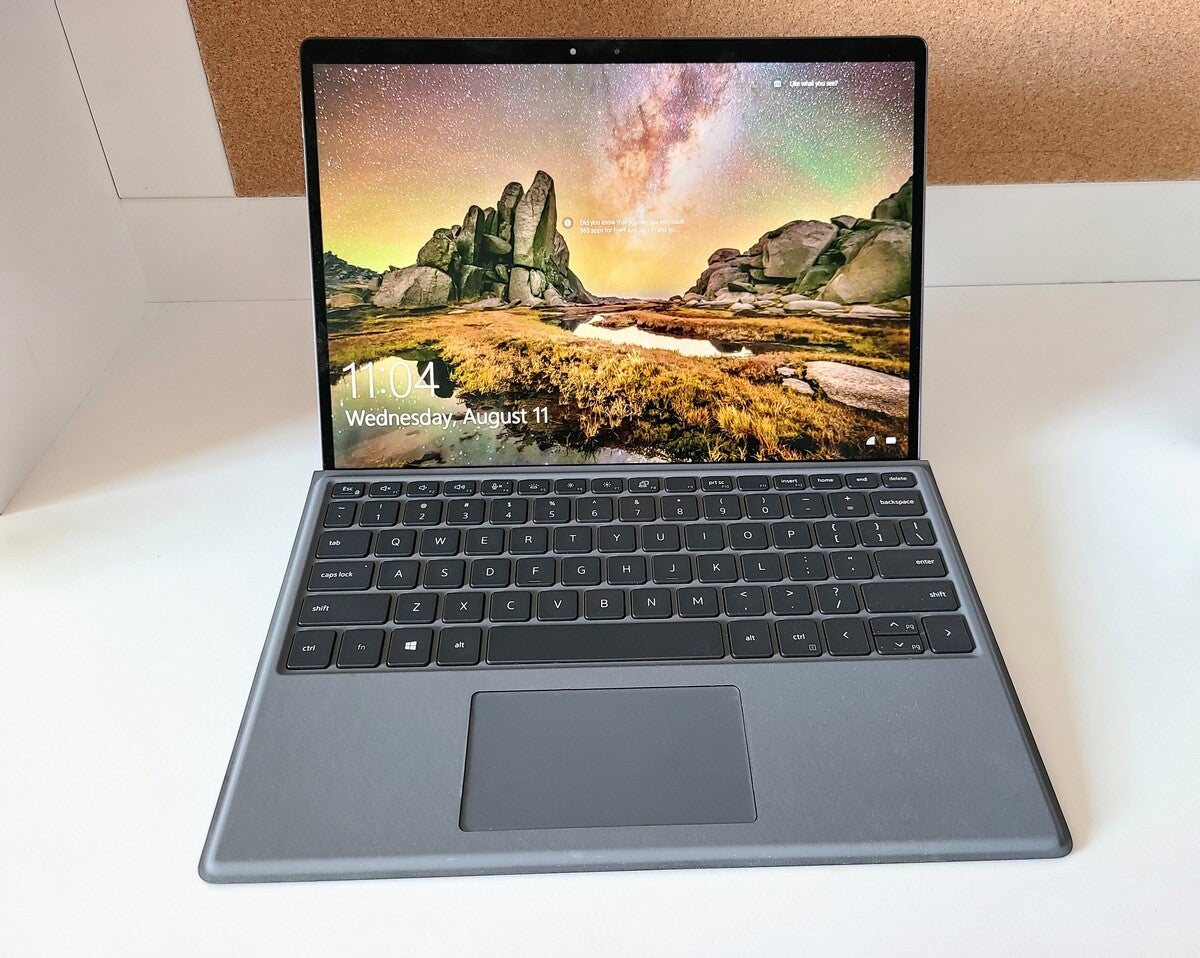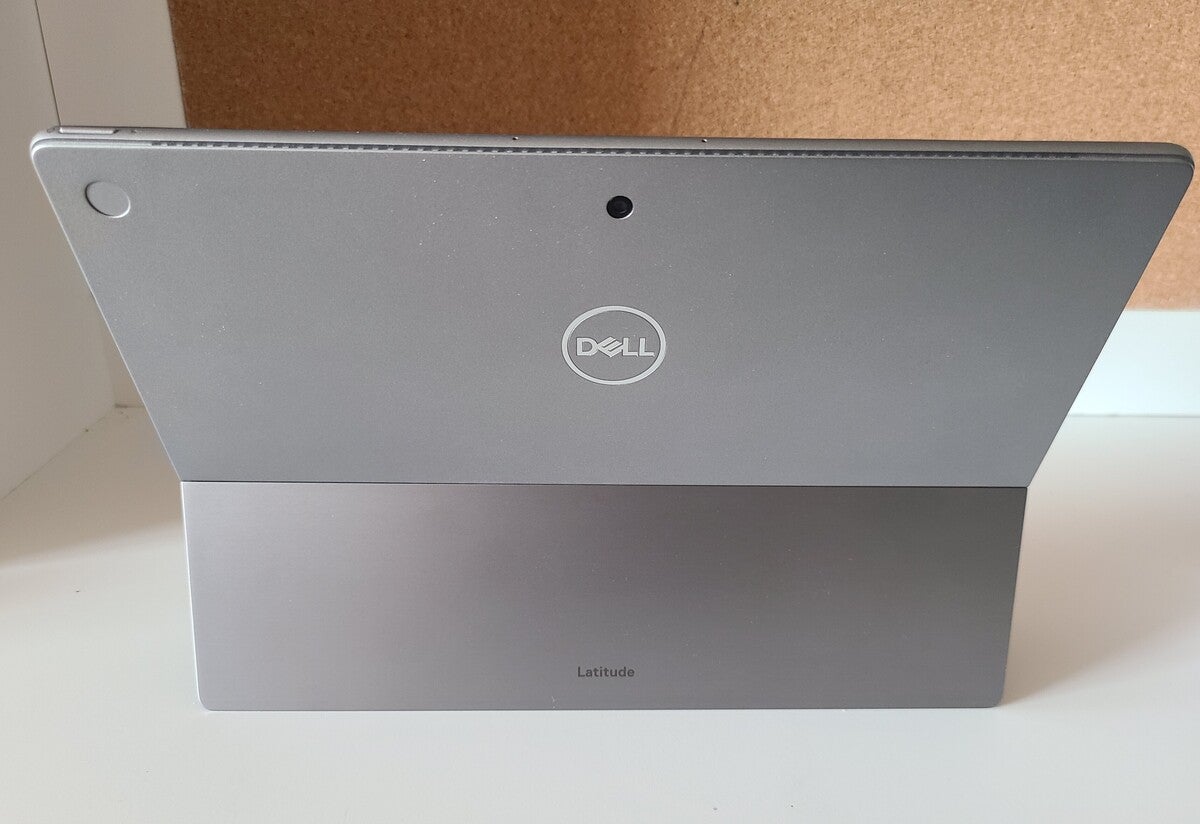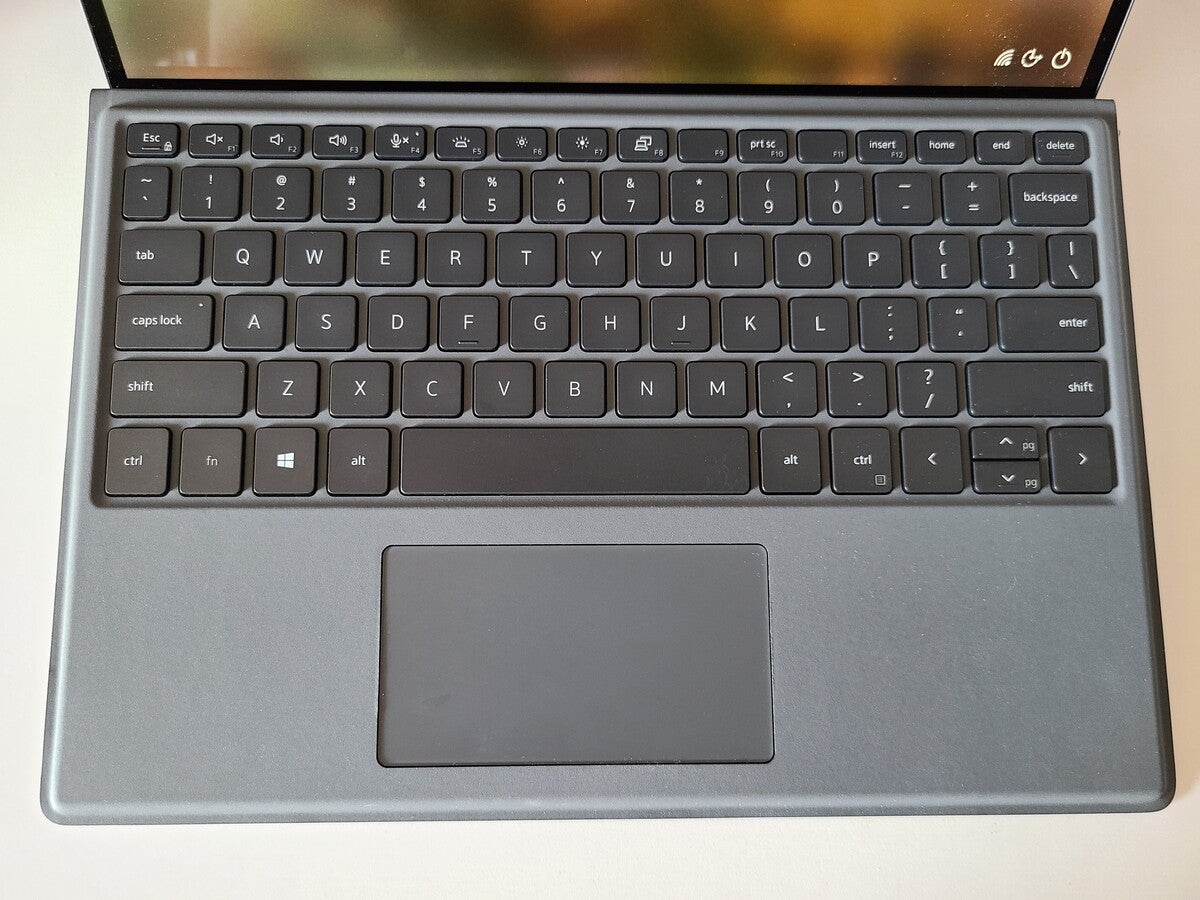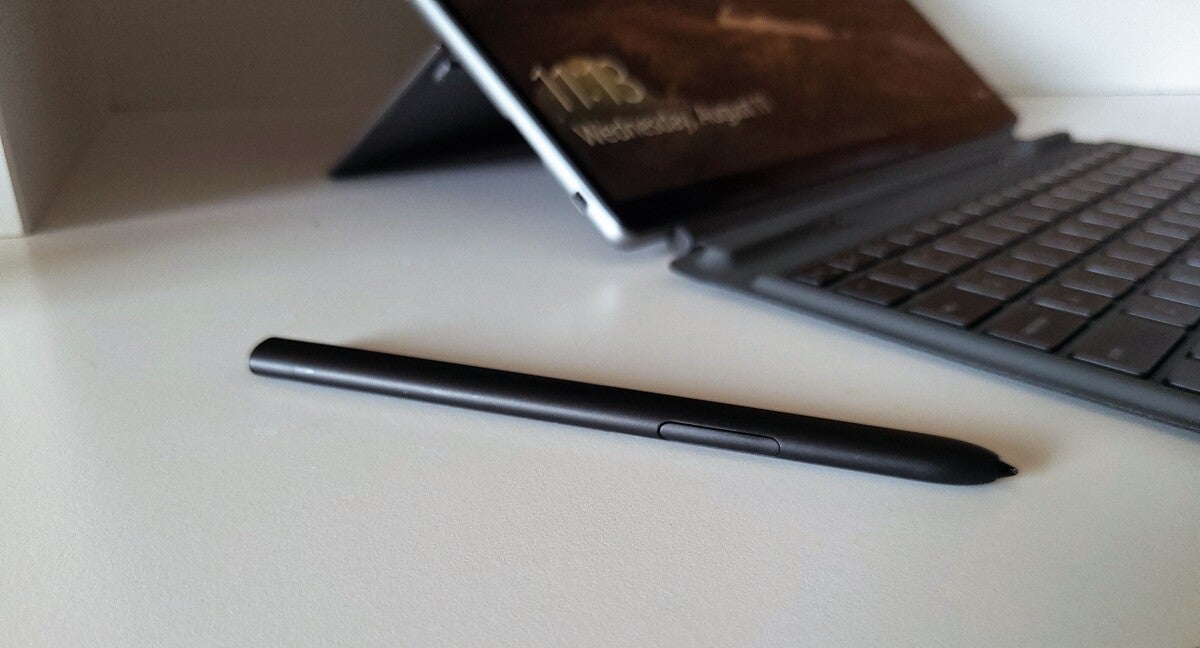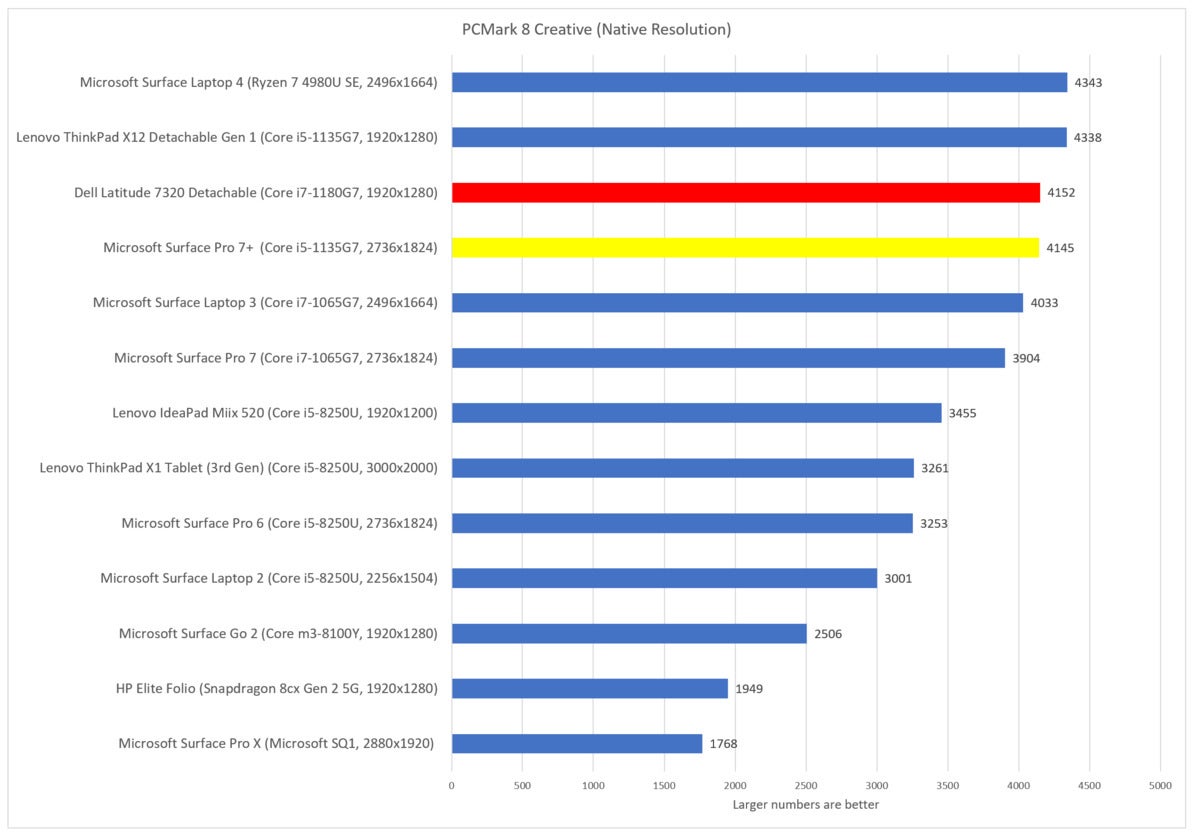At a Glance
Expert’s Rating
Pros
- Large 13.3-inch, bright 500-nit display
- Excellent keyboard for typing
- 1080p webcam
- Thunderbolt 4 ports
- Superb utility suite
Cons
- Weak magnetic keyboard connection
- Expensive unless your company’s buying it
- Pen and keyboard sell separately
Our Verdict
Dell’s Latitude 7320 Detachable offers virtually everything you can ask for of a 2-in-1 tablet PC, aside from the price tag.
Best Prices Today
$2189.00
Dell’s Latitude 7320 Detachable rivals what some may call the definitive Windows tablet, the Microsoft Surface Pro 7+. The Latitude 7320 may be a little more expensive, but it also boasts Thunderbolt connectivity, a one-two punch of biometric security options, and a suite of genuinely useful utilities.
Unfortunately, the Latitude 7320 is not immune to the “lapability” issues we’ve experienced with other 2-in-1 detachable PCs. But that’s the only major flaw we found. Otherwise, the Dell Latitude 7320 Detachable rises to the level of a premier business tablet PC, earning our Editor’s Choice award.
This review is part of our ongoing roundup of the best laptops. Go there for information on competing products and how we tested them.
Dell Latitude 7320 Detachable basic features
Dell’s Latitude 7320 Detachable is available in multiple configurations via Dell.com. We list the major specifications and option below, with our test configuration indicated by “(as tested).”
- Processor: Intel Core i3-1110G4, Core i5-1130G7, Core i5-1140G7, Intel Core i7-1180G7 (Core i7-1180G7 as tested)
- Display: 13.3-inch (1,920×1,280) touch; 500 nits rated
- Memory: 16GB LPDDR4X-4267
- Storage: 256GB PCie SSD M.2
- Graphics: Iris Xe
- Ports: 2 Thunderbolt 4 (Power Delivery, DisplayPort), Wedge lock slot, 3.5mm audio jack, optional microSIM
- Security: Windows Hello (fingerprint reader, depth camera)
- Camera: 1080p depth camera / 4.9MP user-facing; 1080p (video) / 6MP (image) rear-facing
- Battery: 39.2Wh (design); 37.2Wh (full, reported by Windows)
- Wireless: Wi-Fi 6 AX201 2×2 802.11ax 160MHz, Bluetooth 5.1
- Operating system: Windows 10 Pro
- Dimensions: 11.75 x 9.03 x 0.63 inches
- Weight: 1.7 pounds (without keyboard)
- Color: Silver
- Prices: $2,189 (as tested) on Dell.com. Total price (with keyboard and pen) is $2,459.
If that’s a bit too rich for your blood, Dell offers a fully configurable Dell Latitude 7320 DetachableRemove non-product link with a Core i3-1110G4, 4GB of memory, and 128GB of SSD storage for $1,559. (We’d consider those specs too skimpy for practical use.) A Core i5/8GB RAM/256GB versionRemove non-product link is $1,829, while a Core i7/16GB RAM/512GB SSD versionRemove non-product link is $2,329. A premium Core i7/16GB RAM/1TB SSD versionRemove non-product link is priced at $2,539.
The latest Microsoft Surface Pro 7+ forces you to buy the essential Signature Type Cover keyboard and Surface Pen separately. Another rival, the Lenovo ThinkPad X12 Detachable Gen 1, charges extra for the pen. Through a miscommunication, Dell informed us that while the company provided us with a pen and a tablet for our review, the Dell Latitude 7320 Detachable Travel KeyboardRemove non-product link with an included pen costs an additional $199.99. The Dell Latitude 7320 Detachable Active Pen also sells separately, for $69.99.
Latitude 7320 Design
Out of the box, one fundamental experience with the keyboard concerned me. Though I was able to attach the keyboard easily to the tablet via a magnetized connection, the secondary magnets were a lot weaker than I expected.
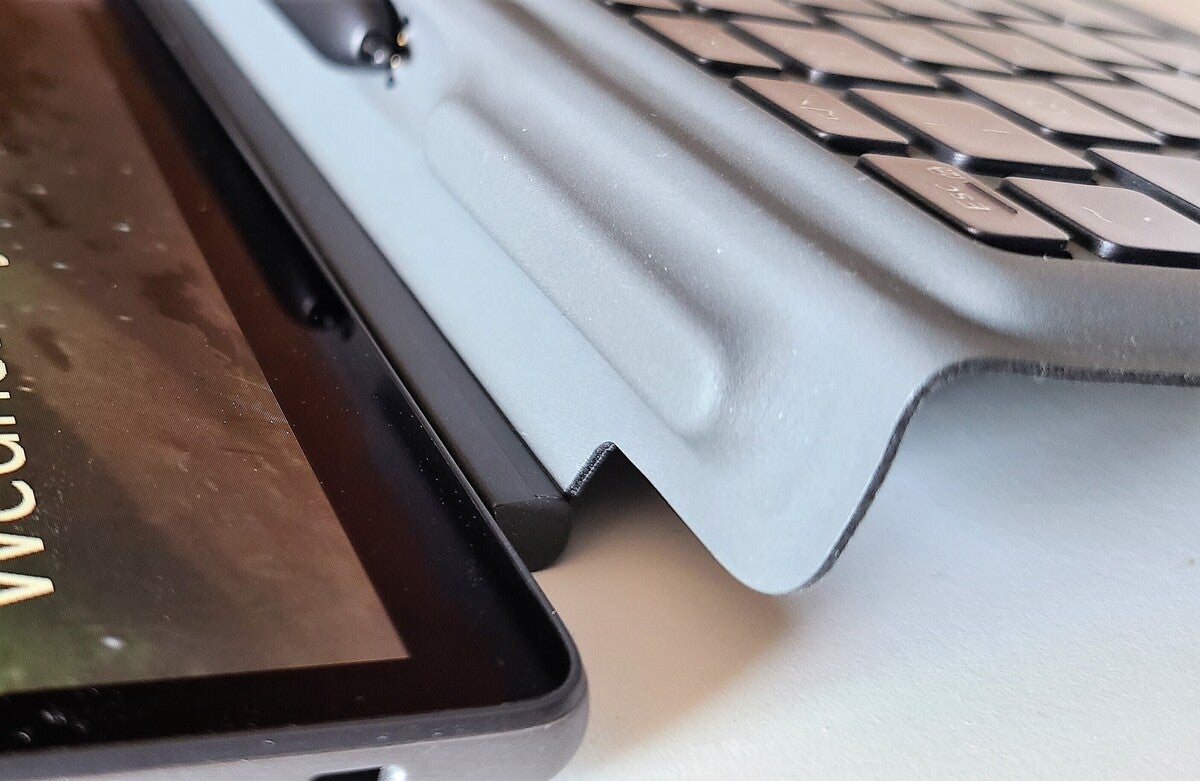
The Dell Latitude 7320 Detachable has a pen cubby that’s convenient, but its location impacts the strength of the secondary hinge—making the keyboard a bit less stable when connected.
Like rival tablets, Dell’s Latitude 7320 keyboard magnetically attaches itself to the tablet via a thin line of electrical contacts. Two tiny plastic pegs that clip the keyboard and tablet together offer additional stability. The keyboard also folds toward the tablet with a secondary hinge, elevating the keyboard at a slight angle. It’s this second hinge that fails to secure the keyboard. That’s fine for working on a flat surface, but on your lap, any rocking motion or sudden movement will likely plunge the tablet like a fat, flat lemming, over your knees to its doom.
Though lightweight, the Latitude 7320 feels structurally sound. Like rival tablets, it includes a small kickstand that supports the tablet at any angle from vertical to just a few degrees off horizontal.
Our review unit offered a very bright display (500-nit maximum brightness), which can be used in the shade of a tree or in a sunny room. The matte screen neatly balanced light output without much glare.
The display is also a key differentiator between the Latitude 7320 and Microsoft’s Surface Pro 7+. Dell’s Latitude 7320 Detachable weighs the same as the Surface Pro 7+, but it’s an inch longer on the diagonal. However, the Latitude’s 1920×1280 display is also lower-resolution than the 2736×1824 display the Surface Pro 7+ provides.
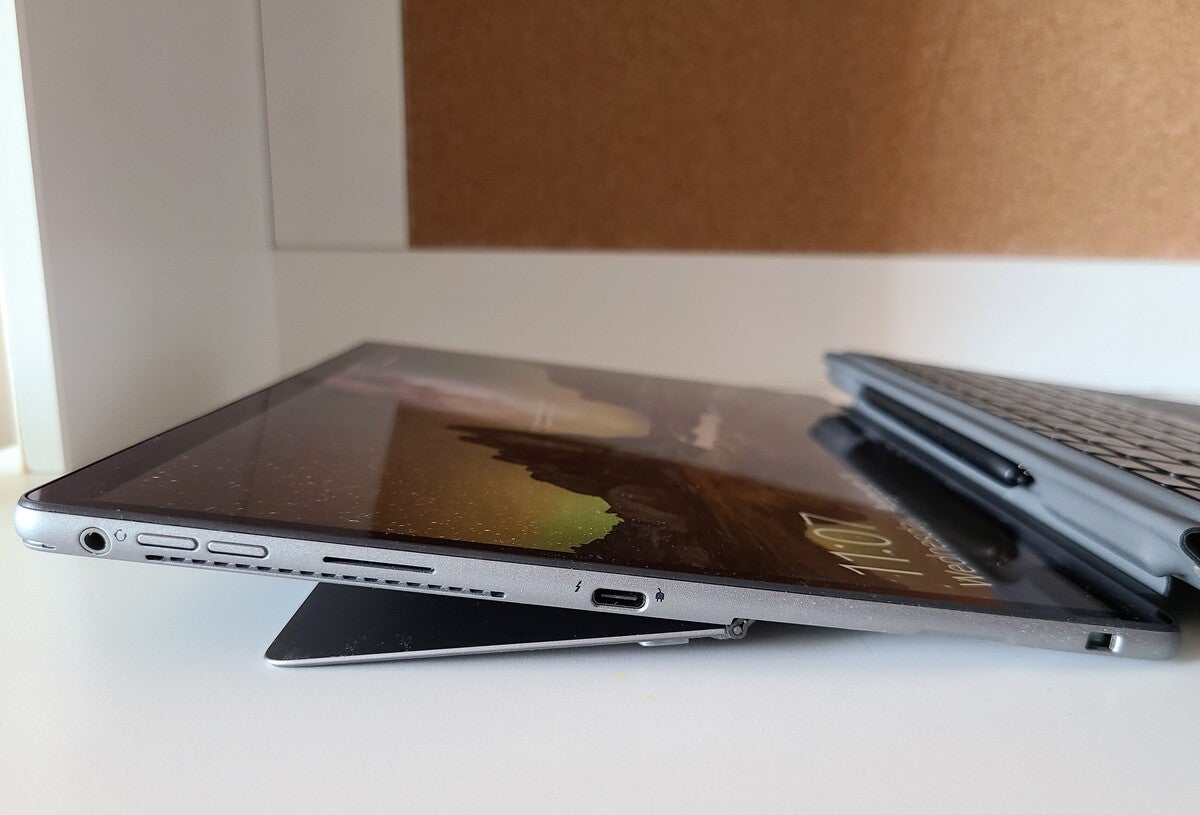
The left side of the Dell Latitude 7320 Detachable includes a headphone jack, volume switches, and a wedge lock slot. The small slit to the right of the volume switches is for the left speaker. The thermal venting is directly below it.
The Latitude 7320 Detachable connects to printers, displays, and other peripherals via a pair of Thunderbolt 4-enabled USB-C ports, one on either side of the display. You’ll likely want to invest in either an inexpensive USB-C hub or a pricier Thunderbolt dock, however, for greatest versatility.
Because this is a tablet designed for the workplace, a number of security solutions are available. Both the Core i5-1140G7 and the Core i7-1180G7 CPU options are vPro-capable. The tablet also includes NFC capabilities and an optional SmartCard reader.
Typing and pen experience
The Latitude 7320 is a business tablet designed for prolonged use. Its excellent keyboard offers large, spacious keys that are quite comfortable to type upon, with two levels of backlighting. The Precision touchpad is a bit on the small side, though slick and clickable all the way to the top. Aside from the weak magnetic connection, the Latitude 7320 Detachable’s keyboard is one of the best tablet keyboards I’ve used.
The Latitude 7320 also incorporates one of the best elements of the Surface Pro X (as well as other tablets by Lenovo and HP): the pen cubby. While the Surface Pro X charges the Surface Slim Pen inductively, Dell’s Latitude 7320 Detachable uses two small metal pads. Drop the Latitude’s pen into the cubby in either direction, and the magnetic grip will spin the pen so that its metallic connectors grab the keyboard contacts and begin charging. That’s the way it’s supposed to work, anyway: Instead, I found that the tablet, rather than the cubby, would attract the pen, causing it to stick to the tablet’s screen rather than fall into the charging cubby.
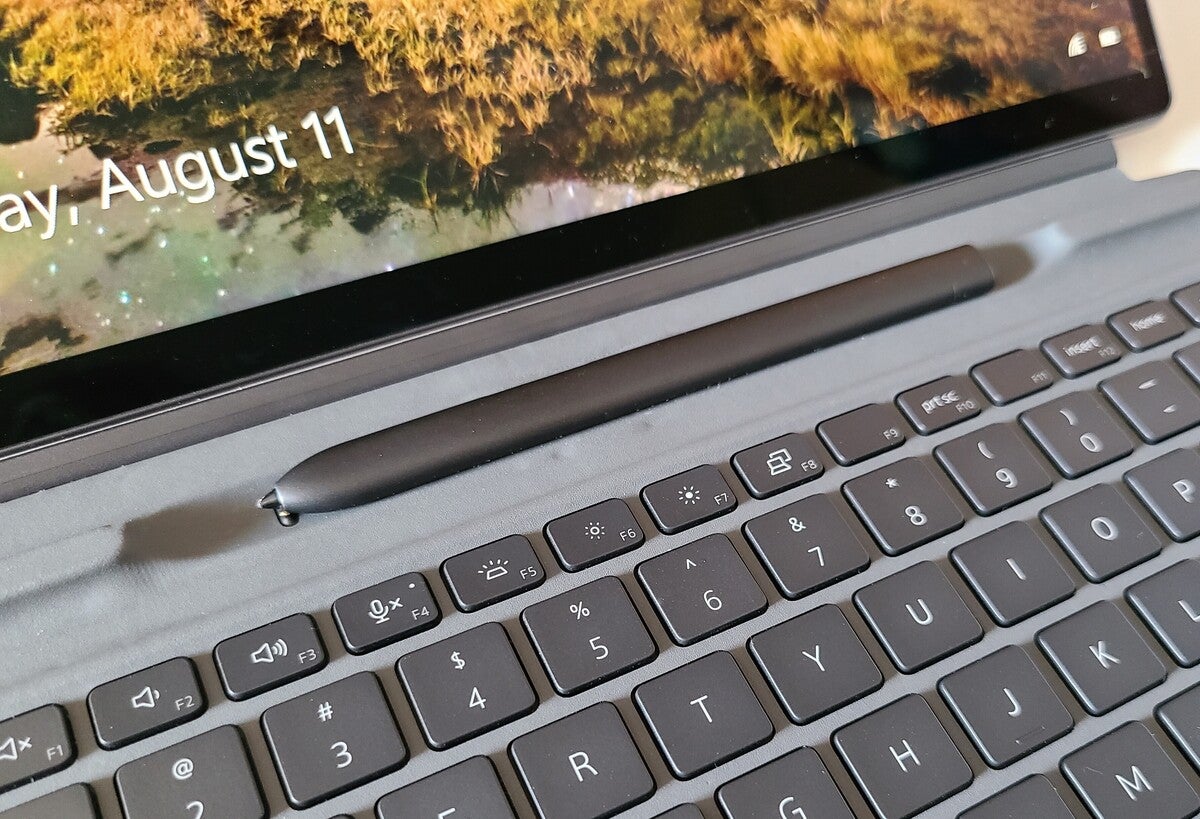
The Dell Latitude 7320 Detachable’s pen cubby includes two charging connectors, allowing you to orient the pen in either direction.
The Latitude 7320 Detachable’s Active Pen is also intriguing for a number of reasons. First, the pen itself appears to have just a single long button, but it doesn’t; there’s a top button and a bottom button, but they’re all a single blob of plastic that rocks back and forth. The top button serves an alternate right-click mouse option, but the bottom button is completely inoperable until the user downloads the Active Pen control panel. This also unlocks the ability of the pen to “hover” over the screen and still interact with it, as well as a radial menu where the pen can be used to control volume settings and audio track controls. Finally, the pen uses a capacitive charging system which fully charges the pen in under 30 seconds, after which its small white LED turns off.
While there’s still a bit of ink lag, my only real complaint with the Active Pen is that it’s flattish and smooth, which meant that it slipped through my fingers more than I would like.
Sound, webcam, and apps
The Dell Latitude 7320 Detachable uses something called Intel Smart Sound Technology for MIPI SoundWire audio, rather than the more common audio-enhancement algorithms. The result, however, sounds more than presentable, with a well-mixed blend of midrange to high-end audio from the speakers mounted behind the tablet’s surface. Unsurprisingly for a tablet, the low-end bass is a half-hearted effort. The overall volume could be a touch louder, too. Really, though, the Latitude’s audio is about as good as you can expect to get from a tablet PC.
The Dell Latitude 7320 Detachable’s webcam has one big thing going for it: the user-facing webcam offers 1080p/30Hz resolution, on a par with the small number of standalone 1080p webcams that offer Windows Hello biometric login capabilities. (720p remains the most common webcam resolution.) Otherwise, the webcam doesn’t offer anything special in terms of its white balance or color accuracy. There’s no physical camera shutter, nor is there a button to disable the webcam on the keyboard. Though some persist in taking photos with Apple iPads and other tablets, the rear camera is probably best used to snap shots of documents and import them into Word or other productivity tools.
The webcam is also Windows Hello-enabled, so that it will learn to look for you and recognize you—literally. One of the features Dell has begun bundling within its laptops and tablets is Wake on Approach, which, if enabled, literally keeps an eye out to see if something it recognizes as a person walks into camera range. Windows Hello then turns on to try and detect your face. It’s a bit unnerving, but it works.
Dell added a secondary Windows Hello device: a fingerprint reader on the rear of the tablet. The reader can identify you in case the Windows Hello camera can’t—if you’ve misplaced your glasses, for example. The fingerprint reader, too, worked as expected.
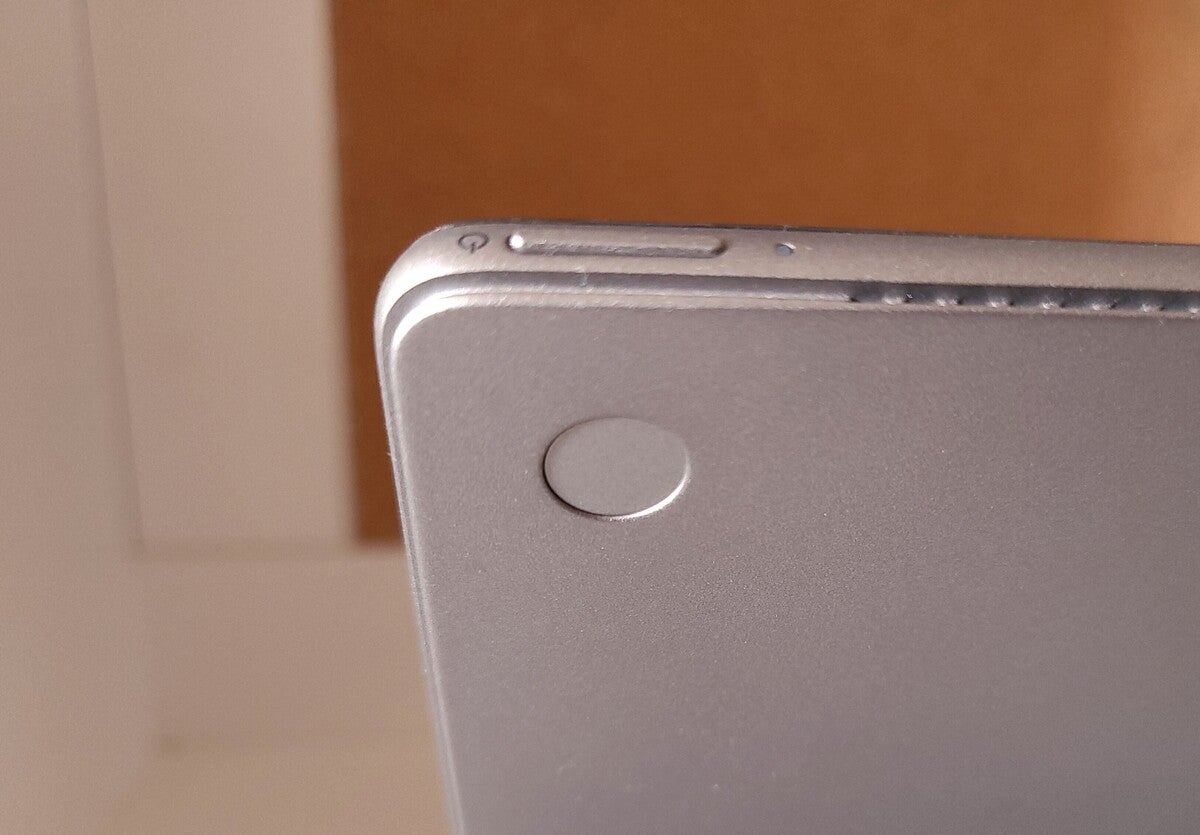
A fingerprint reader on the rear of the tablet serves as an excellent secondary (or, if you prefer, primary) biometric login compatible with Windows Hello.
Unlike the coterie of paid “crapware” that normally accompanies consumer PCs, the business-oriented Dell Latitude 7320 offers stellar utilities: Dell Command | Update, which handles BIOS updates; Dell Power Optimizer, which allows you to manipulate the fan speed and performance settings; and Dell Optimizer, which allows the user to “optimize” for particular applications, and controls the Wake on Approach feature.
Dell Optimizer will also automatically switch your wireless network connection on to a better connection (or just a better wireless channel) if one is available, and adaptively extend your battery life depending upon your PC’s behavior. All three of the Dell apps mentioned above hide such goodies, some of which are turned on by default.
Dell Latitude 7320 Detachable performance
While you’re not going to buy the Dell Latitude 7320 Detachable to play games, it’s worth noting that the 11th-gen Core i7 within it falls into the “Tiger Lake” generation, noteworthy for its advanced, integrated Iris Xe GPU that pushes graphics performance into discrete-GPU territory. You’ll see that performance represented within the graphics benchmarks we offer at the end of the review.
The Dell Latitude 7320 should handle everything that a modern business user will throw at it, including Microsoft Office/365 apps and web browsing. Our review unit includes Windows 10 Pro, which allows CPU-intensive virtualization features that Windows 10 Home does not. That’s still saying something, as tablets generally don’t offer the type of performance that a thicker, higher-power mainstream notebook would. We performed real-world tests with streaming 4K/60 video, which the Latitude 7320 handled without any noticeable frame drops.
We evaluated the Dell Latitude 7320 Detachable as one of the three major offerings in the tablet space for 2021, along with the Microsoft Surface Pro 7+ and the Lenovo ThinkPad X12 Detachable Gen 1. We’ve highlighted the Dell Latitude 7320 Detachable in red, and the Surface Pro 7+, its chief competitor, in yellow in the charts below. Incidentally, Dell configured its Windows power/performance slider at the midrange setting. Microsoft uses the lowest-performance/longest-battery life setting instead, which does make a small difference; you can read the Surface Pro 7+ review to discover how much.
We’ve included the business-minded HP Elite Folio in our charts below as well. Because it uses an Arm processor, some of our standard benchmarks couldn’t be run.
We use UL’s PCMark 10 benchmark suite as an approximation of how the tablet will perform under real-world conditions. The benchmark bundles up videoconferencing, web browsing, image and video editing, even CAD work, measuring the tablet’s performance each step of the way. PCMark 10 then tallies up the aggregate score.

As a business notebook, the Dell Latitude 7320 Detachable starts off strong, as the leader in overall application performance.
It’s a strong start for the Dell Latitude 7320 Detachable. It leads the pack in PCMark 10, well ahead of the Surface Pro 7+ and all other comers.
The older PCMark 8 Creative test offers greater compatibility with older notebooks, as well as the HP Elite Folio. Here, the Latitude 7320 splits the difference, falling a little behind the Lenovo ThinkPad X12 Detachable but remaining extremely competitive with the Surface Pro 7+.
We use the Cinebench R15 benchmark as a measure of general CPU performanceThe tablet is asked to render a 3D scene, which it can do under “turbo” or burst conditions. As you might expect from a high-end 11th-gen Core chip, it performs quite well, though we’d expect performance would be slightly less than a full-fledged notebook PC (see the Surface Laptop 4 way ahead of the others).
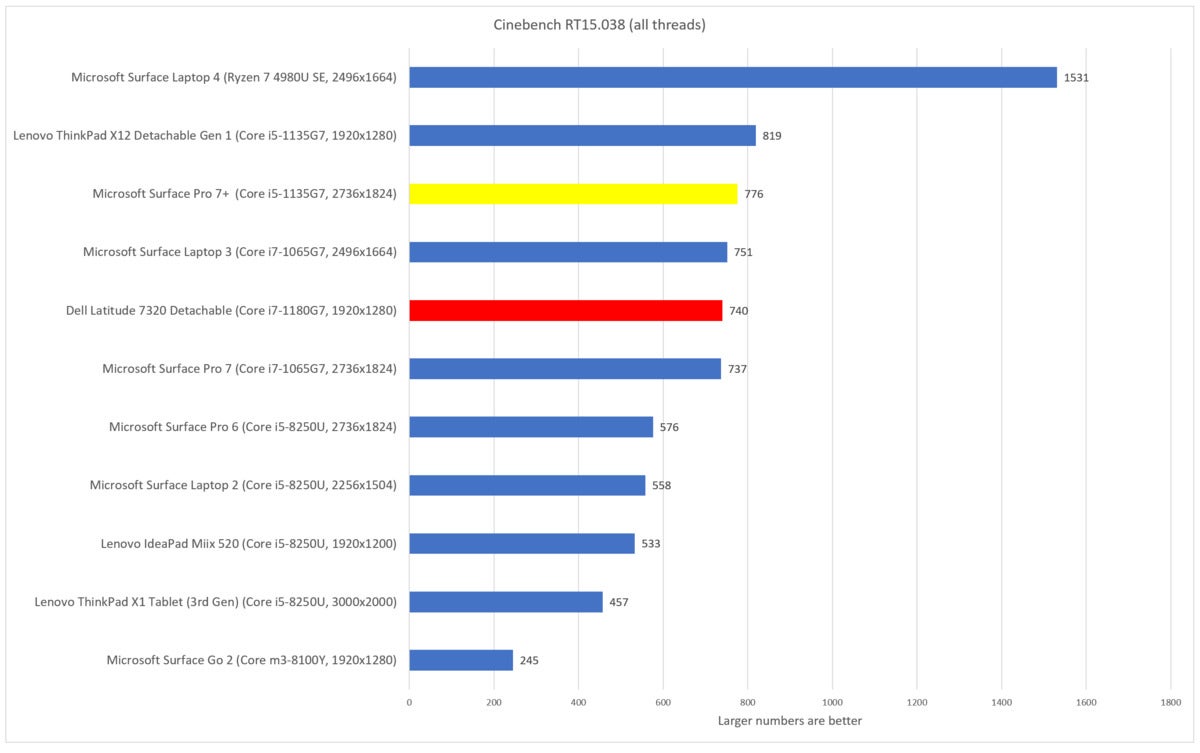
Dell’s Latitude 7320 Detachable largely keeps up with Microsoft’s Surface Pro 7+ in this general CPU test.
We also compared the performance of the Dell Latitude 7320 while running the Cinebench R23 benchmark, which offers you the option to compute a score for a single benchmark run, but also generates an average score over a prolonged, looped test that lasts for ten minutes. If the two scores are comparable, then we can conclude that the tablet doesn’t thermally throttle itself over prolonged loads. That’s not the case here, unfortunately, as performance dropped by 12 percent over the prolonged test.
HandBrake, an open-source video transcoding tool, reconfigures a high-resolution Hollywood movie into a low-resolution format for a tablet. It’s an intensive task, one that can show whether a laptop is able to keep cool. This benchmark also marks how well the Latitude 7320 Detachable performs over time, while generating a real-world performance score.
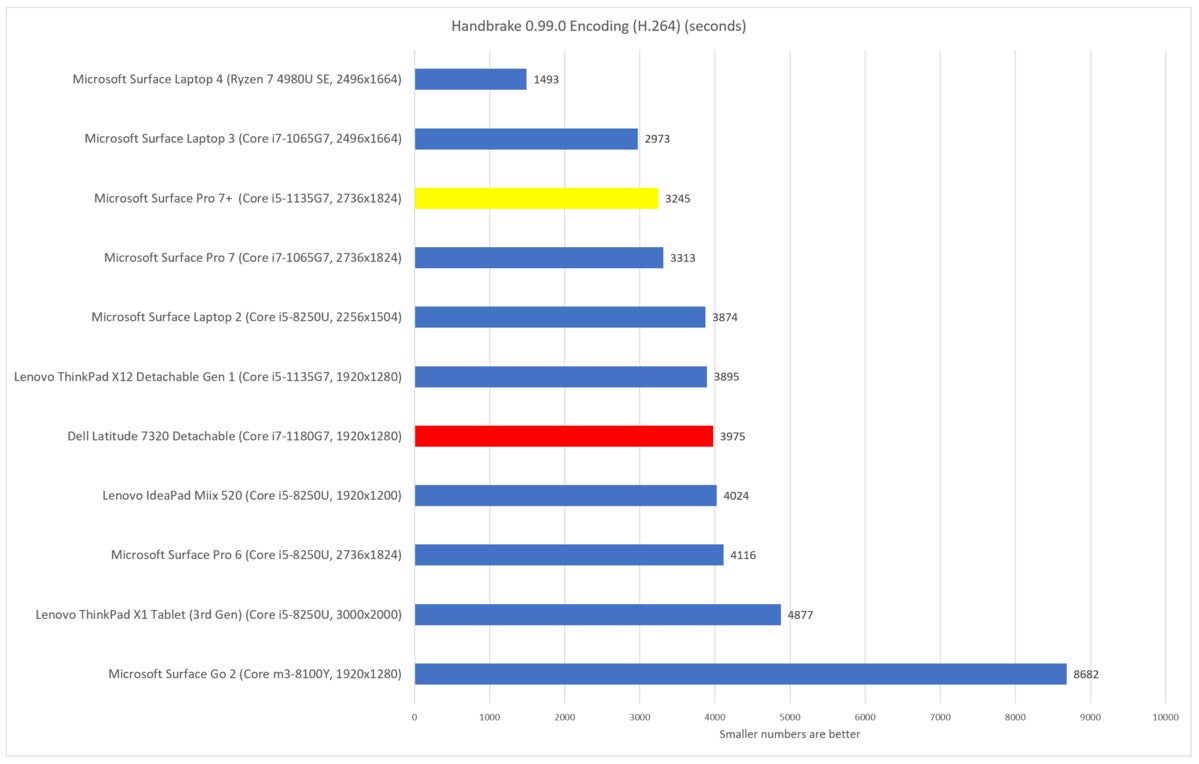
It’s also possible that we’re seeing some evidence of thermal throttling in this prolonged Handbrake transcoding test.
Our last test measures 3D performance by UL’s 3DMark “Time Spy” benchmark. Again, we don’t expect you’ll buy the Dell Latitude 7320 Detachable to play games, though it’s nice to know whether you have the option. (If you can’t, Microsoft’s Xbox cloud gaming for Windows PCs has you covered.)
Both the 3DMark Time Spy and Night Raid (not shown) benchmarks reported that you can expect frame rates of over 30 frames per second in Battlefield V, a popular first-person shooter, at 1080p Ultra resolution—not great, but not shabby for a business tablet!

Thicker, more powerful notebooks distribute more power to integrated GPUs, and you’re seeing that with the Dell XPS 13, above. Still, the 3D performance here is excellent for a tablet.
The other key measure of a laptop or tablet is battery life. In a tablet, this is often limited by weight and thickness, and there’s an absolutely massive drop in battery capacity between the Latitude 7320 Detachable’s 37.2Wh battery and the 48.9Wh battery of the Surface Pro 7+. Will the reduced resolution of the Latitude 7320 Detachable make a difference? Yes—the battery-life race ends in a dead heat, about 10 hours each.
(Note two things: by default, the Dell Optimizer app turns on adaptive power management, which extends battery life in certain situations. Because this was on by default, we left it in place. The other, Adaptive Charge, also preserves the overall lifespan of the battery by preventing it from fully charging—in this case, up to about 96 percent, rather than 100 percent. Again, this was on by default, and somewhat cancelled out the effects of the adaptive power management. Our tests reflect both settings.)
Should you buy the Dell Latitude 7320 Detachable?
We’ve given the Dell Latitude 7320 Detachable four stars, evidence that this is a solid effort from Dell in the Windows tablet PC space. As we’ve noted in our other tablet reviews, price matters. Even with the addition of the pen and keyboard, our review unit of the Latitude 7320 costs more than the comparable Microsoft Surface Pro 7+. From a performance standpoint, Dell’s tablet ranks about equal or slightly behind the Surface Pro 7+.
Still, the Latitude 7320 is smartly designed, with a wealth of convenient hardware and software features that certainly make the tablet a pleasure to use. For that, we’re awarding the Dell Latitude 7320 Detachable an Editor’s Choice award, as one of the PC tablets we’d recommend of this current generation.
Correction (10/15/21): Through a miscommunication, Dell informed us that while the company provided us with a pen and a tablet for our review, Dell doesn’t bundle a pen and keyboard with the Dell Latitude 7320 Detachable. The keyboard costs an additional $199.99, and the pen is priced at $70. Our recommendation remains unchanged.
As PCWorld’s senior editor, Mark focuses on Microsoft news and chip technology, among other beats. He has formerly written for PCMag, BYTE, Slashdot, eWEEK, and ReadWrite.


